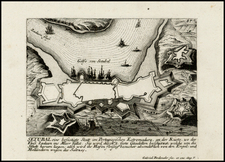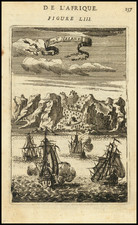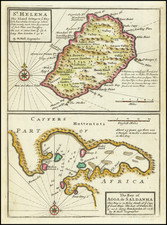Rare separately published map of Madeira, bearing the imprint of both a Swiss and English publisher.
The map was constructed by J.M. Ziegler, a corresponding member of the Royal Geographical Society, drawing from Captain Vidal's earlier work with added corrections. Published in 1856, this map is dedicated to the Royal Geographical Society and offers an intricate portrayal of Madeira's rugged topography and unique botanical landscape.
The map is characterized by its detailed representation of Madeira's mountainous terrain, revealing the island's volcanic origins through its depiction of deep chasms, steep precipices, and high peaks. It is evident from Ziegler's work that the island's geography is marked by a stark contrast between its northern and southern slopes, which is significant for understanding the local climate, vegetation, and suitability for various agricultural endeavors.
J.M. Ziegler's notes accompanying the map provide an invaluable explanation, illustrating how the island's relief impacts the distribution of flora across different altitudes and orientations. These details not only highlight the prevalence of vine cultivation, particularly in the more sun-exposed southern gorges and valleys but also the presence of chestnut woods and the cultivation of rye and wheat at higher elevations.
The map's annotations indicate a landscape that has been shaped by its volcanic legacy yet is no longer marked by active eruptions. Instead, the focus is on the island's potential for scientific study, particularly in meteorology and botany, due to the clear demarcation of north and south-facing slopes that exhibit distinctly different vegetation patterns and microclimates.
Ziegler's emphasis on the island's suitability for meteorological observation suggests that Madeira was recognized for its potential to contribute to the broader scientific understanding of weather patterns and their relation to geography. The map thus provides a window into the mid-19th century scientific exploration and the growing interest in the empirical study of natural environments.
Edward Stanford (1827-1904) was a prominent British mapmaker and publisher. A native of Holborn in the heart of London, Edward was apprenticed to a printer and stationer at the age of 14. After his first master died, he worked with several others, including Trelawny W. Saunders of Charing Cross. Saunders oversaw young Edward’s early career, ensuring that he became a Fellow of the Royal Geographical Society. Associations with the Society eventually brought Sanders much business and gave him a reputation as a publisher of explorers. As testament to this reputation, the Stanford Range in British Columbia was named for him by John Palliser.
Stanford briefly partnered with Saunders in 1852 before striking out on his own in 1853. He was an agent for the Ordnance Survey, the Admiralty, the Geological Survey, the Trigonometrical Survey of India, and the India Office. He also controlled the maps of the Society for the Diffusion of Useful Knowledge, another lucrative source of income. In 1857, Stanford founded his namesake Geographical Establishment, with Saunders and A. K. Johnston as engravers. Thereafter, Stanford was known for his “library maps”, particularly those of Africa and Asia.
Addresses and Years of Operation:
- 6 Charing Cross, London (1848): Edward Stanford's initial place of employment at Trelawney Saunders' shop.
- 7 and 8 Charing Cross, London (1853): Stanford expanded his shop to these addresses.
- 55 Charing Cross, London (1873): The shop moved to this larger location.
- 12-14 Long Acre, London (1873): Site of the new print works and current flagship store.
- 7 Mercer Walk, London (2019): Stanfords moved to this address, continuing its legacy.
Stanford's work with Chief Cartographer John Bolton, including the 1858 Library Map of Europe, positioned the company as a leader in quality cartography during a time of exploration and colonialism. Their 1862 Library Map of London earned acclaim from the Royal Geographical Society. With the business thriving, Stanford purchased Staunton & Son in 1877 and, upon retiring in 1885, handed over the reins to his son, Edward Stanford II.
As sole agents for Ordnance Survey Maps, the company's influence and reputation grew, culminating in the Stanford’s London Atlas Of Universal Geography, which was presented to Queen Victoria in 1887. The transition into the 20th century saw further integration of retail, print, and cartographic operations at Long Acre.
During World War I, Stanford's became an essential publisher for the War Office. Edward Fraser Stanford took over in 1917, steering the company through the interwar period and innovations, such as the world’s smallest maps in 1922 and the Daily Mail Motor Road Map in 1926.
Withstanding a bombing in WWII, the company continued under the stewardship of John Keith Stanford and was sold to George Philip & Son in 1947. As it adapted to the digital age, Stanfords received the Ordnance Survey Premier Partner status in 2007 and ventured into online mapping and data services.
Stanfords, now an icon for travellers and explorers, has maintained its cultural relevance and retail success well into the 21st century, underpinned by a legacy of entrepreneurial spirit and commitment to cartographic excellence.











![[ Morocco ] Statuum Maroccanorum, Regnorum nempe Fessani, Maroccani, Tafiletanin et Segelomessani Secundum suas Provincias accurate divisorum, Typus generalis novus . . . 1728](https://storage.googleapis.com/raremaps/img/small/95640.jpg)

![[Madagascar] S. Lorenzo](https://storage.googleapis.com/raremaps/img/small/71937.jpg)


![[Ascension Island] The True Description of the Island of Ascention lyeing under 8 degrees on ye South syde of ye Equinoctiall lyne.](https://storage.googleapis.com/raremaps/img/small/78964.jpg)